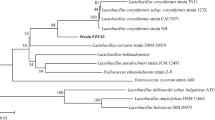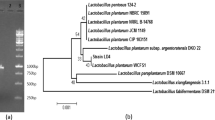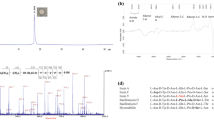Abstract
Lactic acid bacteria produce various antibacterial peptides such as bacteriocins that are active against pathogenic and spoilage microorganisms. Very little attention has been paid to the production of lysozyme as an antimicrobial enzyme. The present work represents one of the few studies reporting lysozyme production by enterococci. Indeed, this study was first conducted to evaluate the antimicrobial activity of Enterococcus lactis Q1, an enterocin P-producing strain previously isolated from fresh shrimp (Penaeus vannamei), against multidrug-resistant clinical isolates. Results showed significant inhibitory activity (P < 0.05) towards diverse pathogens. The purification of the antimicrobial substances produced by Q1 strain leads to the isolation of two active fractions. The SDS-PAGE and mass spectrometry analyses of fraction number 2 (fraction 2) revealed the presence of a protein with molecular mass of 14.3 kDa. Additionally, the experimental results are consistent with mass spectra of industrial lysozyme (Fluka ref. 62970). The lysozyme produced by Enterococcus lactis Q1 strain was confirmed by a plate method against Micrococcus luteus ATCC 4698. Also, sensitivity of the Q1 strain to different concentrations of lysozyme was investigated. For the first time, this study shows that E. lactis Q1 produces lysozyme which could be an excellent candidate in food biopreservation or production of functional foods to promote health benefits.




Similar content being viewed by others
References
Cavera, V. L., Arthur, T. D., Kashtanov, D., & Chikindas, M. L. (2015). Bacteriocins and their position in the next wave of conventional antibiotics. International Journal of Antimicrobial Agents, 46(5), 494–501.
Kovalenko, N. K., & Kasumova, S. A. (1996). The lysozyme-synthesizing activity of enterococci and lactobacilli, Mikrobiolohichnyĭ Zhurnal, 58, 12–8. [In Russian, English abstract].
Kovalenko, N. K., Nemirovskaia, L. N., & Kasumova, S. A. (1999). The bacteriocinogenic and lysozyme-synthesizing activity of lactobacilli. Mikrobiolohichnyĭ Zhurnal, 61, 42–50. [In Russian, English abstract].
Saurabh, S., & Sahoo, P. K. (2008). Lysozyme: an important defence molecule of fish innate immune system. Aquaculture Research, 39(3), 223–239.
Beckert, A., Wiesner, J., Baumann, A., Pöppel, A. K., Vogel, H., & Vilcinskas, A. (2015). Two c-type lysozymes boost the innate immune system of the invasive ladybird Harmonia axyridis. Development Comparative Immunology, 49(2), 303–312.
Narmadha, G., & Yenugu, S. (2016). In silico and biochemical characterization of lysozyme-like proteins in the rat. PLoS One, 11, e01619092016.
Brasca, M., Morandi, S., Silvetti, T., Rosi, V., Cattaneo, S., & Pellegrino, L. (2013). Different analytical approaches in assessing antibacterial activity and the purity of commercial lysozyme preparations for dairy application. Molecules, 18(5), 6008–6020.
Gyawali, R., & Ibrahim, S. A. (2014). Natural products as antimicrobial agents. Food Control, 46, 412–429.
Ercan, D., & Demirci, A. (2016). Recent advances for the production and recovery methods of lysozyme. Critical Reviews in Biotechnology, 36(6), 1078–1088.
Yi, S., Dai, F., Ma, Y., Yan, T., Si, Y., & Sun, G. (2017). Ultrafine silk-derived nanofibrous membranes exhibiting effective lysozyme adsorption. ACS Sustainable Chemistry and Engineering, 5(10), 8777–8784.
Nakimbugwe, D., Masschalck, B., Anim, G., & Michiels, C. W. (2006). Inactivation of Gram-negative bacteria in milk and banana juice by hen egg white and lambda lysozyme under high hydrostatic pressure. International Journal of Food Microbiology, 112(1), 19–25.
Bera, A., Herbert, S., Jakob, A., Vollmer, W., & Götz, F. (2005). Why are pathogenic staphylococci so lysozyme resistant? The peptidoglycan O-acetyltransferase OatA is the major determinant for lysozyme resistance of Staphylococcus aureus. Molecular Microbiology, 55, 778–787.
Branen, J. K., & Davidson, P. M. (2004). Enhancement of nisin, lysozyme, and monolaurin antimicrobial activities by ethylenediaminetetraacetic acid and lactoferrin. International Journal of Food Microbiology, 90(1), 63–74.
Jay, J. M. (1966). Production of lysozyme by staphylococci and its correlation with three other extracellular substances. Journal of Biotechnology, 91, 1804–1810.
Holt, R. J. (1971). Lysozyme production by staphylococci and micrococci. Journal of Medical Microbiology, 4(3), 375–379.
Ben Braïek, O., Ghomrassi, H., Cremonesi, P., Morandi, S., Fleury, Y., Le Chevalier, P., Hani, K., Bel Hadj, O., & Ghrairi, T. (2017). Isolation and characterisation of an enterocin P-producing Enterococcus lactis strain from a fresh shrimp (Penaeus vannamei). Antonie Van Leeuwenhoek, 110(6), 771–786.
Laemmli, U. K. (1970). Cleavage of structural proteins during the assembly of the head of bacteriophage T4. Nature, 227(5259), 680–685.
Morandi, S., Silvetti, T., & Brasca, M. (2013). Biotechnological and safety characterization of Enterococcus lactis, a recently described species of dairy origin. Antonie Van Leeuwenhoek, 103(1), 239–249.
Silvetti, T., Brasca, M., Lodi, R., Vanoni, L., Chiolerio, F., de Groot, M., & Bravi, A. (2010). Effects of lysozyme on the microbiological stability and organoleptic properties of unpasteurized beer. Journal of the Institute of Brewing, 116(1), 33–40.
van de Beek, D., de Gans, J., Tunkel, A. R., & Wijdicks, E. F. M. (2006). Community-acquired bacterial meningitis in adults. The New England Journal of Medicine, 354, 44–53.
Safaei, H. G., Moghim, S., Isfahani, B. N., Fazeli, H., Poursina, F., Yadegari, S., Nasirmoghadas, P., Abolfazl, S., & Nodoushan, H. (2017). Distribution of the strains of multidrug-resistant, extensively drug-resistant, and pandrug-resistant Pseudomonas aeruginosa isolates from burn patients. Advanced Biomedical Research, 6(1), 74.
Bigliardi, B., & Galati, F. (2013). Innovation trends in the food industry: the case of functional foods. Trends in Food Science & Technology, 31(2), 118–129.
Kerry, R. G., Patra, J. K., Gouda, S., Park, Y., Shin, H. S., & Das, G. (2018). Benefaction of probiotics for human health: a review. Journal of Food and Drug Analysis, 26(3), 927–939. https://doi.org/10.1016/j.jfda.2018.01.002.
Zhang, X., Wang, Y., Sun, M., Ren, X., Zou, Y., Wang, Q., & Wang, W. (2008). Purification and properties of lysozyme from a marine strain. Annals of Microbiology, 58(1), 89–94.
Yan, L., Shen, S., Yun, J., & Yao, K. (2011). Isolation of lysozyme from chicken egg white using polacrylamide-based cation-exchange cryogel. Chinese Journal of Chemical Engineering, 19(5), 876–880.
Derde, M., Guérin-Dubiard, C., Lechevalier, V., Cochet, M. F., Jan, S., Baron, F., Gautier, M., Vié, V., & Nau, F. (2014). Dry-heating of lysozyme increases its activity against Escherichia coli membranes. Journal of Agricultural and Food Chemistry, 62(7), 1692–1700.
Hukić, M., Seljmo, D., Ramovic, A., Ibrišimović, M. A., Dogan, S., Hukic, J., & Feric Bojic, E. (2017). The effect of lysozyme on reducing biofilms by Staphylococcus aureus, Pseudomonas aeruginosa, and Gardnerella vaginalis: an in vitro examination. Microbial Drug Resistance. https://doi.org/10.1089/mdr.2013.0303.
Cintas, L. M., Casaus, P., Havarstein, L. S., Hernandez, P. E., & Nes, I. F. (1997). Biochemical and genetic characterization of enterocin P, a novel sec-dependent bacteriocin from Enterococcus faecium P13 with a broad antimicrobial spectrum. Applied and Environmental Microbiology, 63, 4321–4330.
Funding
This work was supported by a grant from the Ministry of High Education, Tunisia.
Author information
Authors and Affiliations
Corresponding author
Ethics declarations
Conflict of Interest
The authors declare that they have no conflict of interest.
Additional information
Highlights
● Antimicrobial activity of Enterococcus lactis strain Q1 against multidrug bacteria
● Purification of E. lactis strain Q1 using two-step procedure
● Detection of significant production of lysozyme by E. lactis Q1
● This work is the first report on lysozyme production and purification in E. lactis
● E. lactis Q1 is a good candidate in food biopreservation or in antibiotherapy
Rights and permissions
About this article
Cite this article
Ben Braïek, O., Smaoui, S., Fleury, Y. et al. Bio-guided Purification and Mass Spectrometry Characterisation Exploring the Lysozyme-like Protein from Enterococcus lactis Q1, an Unusual Marine Bacterial Strain. Appl Biochem Biotechnol 188, 43–53 (2019). https://doi.org/10.1007/s12010-018-2886-0
Received:
Accepted:
Published:
Issue Date:
DOI: https://doi.org/10.1007/s12010-018-2886-0




